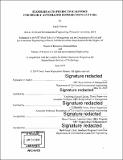| dc.contributor.advisor | Yanchong (Karen) Zheng and Saurabh Amin. | en_US |
| dc.contributor.author | Stinson, Emily(Emily Anne Matsushino) | en_US |
| dc.contributor.other | Sloan School of Management. | en_US |
| dc.contributor.other | Massachusetts Institute of Technology. Department of Civil and Environmental Engineering. | en_US |
| dc.contributor.other | Leaders for Global Operations Program. | en_US |
| dc.date.accessioned | 2019-10-04T21:35:13Z | |
| dc.date.available | 2019-10-04T21:35:13Z | |
| dc.date.copyright | 2019 | en_US |
| dc.date.issued | 2019 | en_US |
| dc.date.issued | 2019 | en_US |
| dc.identifier.uri | https://hdl.handle.net/1721.1/122448 | |
| dc.description | Thesis: S.M., Massachusetts Institute of Technology, Department of Civil and Environmental Engineering, in conjunction with the Leaders for Global Operations Program at MIT, 2019 | en_US |
| dc.description | Thesis: M.B.A., Massachusetts Institute of Technology, Sloan School of Management, in conjunction with the Leaders for Global Operations Program at MIT, 2019 | en_US |
| dc.description | Cataloged from PDF version of thesis. | en_US |
| dc.description | Includes bibliographical references (page 53). | en_US |
| dc.description.abstract | While automated mobile inventory systems have greatly increased productivity, it has also created a new set of operational challenges. Floor health events, such as fallen product, spills, disabled robots, and floor access can degrade overall floor performance by obstructing access to product, forcing robots to re-route to less efficient paths, exacerbating congestion, increasing idle time, and potentially reducing throughput. Floor health issues are interdependent and have cascading effects, making their impacts difficult to track, visualize, and address. Reactive support and reliance on training and adoption of best practices is not scalable. As the network continues to grow, there is a need to improve real-time visibility and preventative measures into floor conditions. This project consisted of five main phases: research, hypothesis, testing, evaluation, and implementation. | en_US |
| dc.description.abstract | The research phase was dedicated to developing an understanding of the current processes and problem statement. Then a testable hypothesis was constructed based on observations and data exploration. The hypothesis was tested via simulations and statistical analysis. The evaluation phase included analyzing the implications and use-cases of the results. The last phase of the project included developing and implementing selected applications. The model development phase of the project included simulation experiments where the dependent variable collected was the percentage change in average throughput rate and a multitude of potential explanatory features were tracked. Analysis of this data revealed that some of the best predictors of degradation of throughput rate were the types of floor cells being blocked. | en_US |
| dc.description.abstract | There is wide range of impactful applications of these findings, including diagnostic checks to help root cause issues, automated notifications that highlight deteriorating floor conditions, automated user path planning, actionable floor metrics, and prioritization of work. Automated notifications to proactively identify deteriorating floor conditions, real-time prioritization of tasks, and a diagnostic tool were the implementations focused on during this project. | en_US |
| dc.description.statementofresponsibility | by Emily Stinson. | en_US |
| dc.format.extent | 53 pages | en_US |
| dc.language.iso | eng | en_US |
| dc.publisher | Massachusetts Institute of Technology | en_US |
| dc.rights | MIT theses are protected by copyright. They may be viewed, downloaded, or printed from this source but further reproduction or distribution in any format is prohibited without written permission. | en_US |
| dc.rights.uri | http://dspace.mit.edu/handle/1721.1/7582 | en_US |
| dc.subject | Sloan School of Management. | en_US |
| dc.subject | Civil and Environmental Engineering. | en_US |
| dc.subject | Leaders for Global Operations Program. | en_US |
| dc.title | Floor health predictive support for highly automated distribution centers | en_US |
| dc.type | Thesis | en_US |
| dc.description.degree | S.M. | en_US |
| dc.description.degree | M.B.A. | en_US |
| dc.contributor.department | Sloan School of Management | en_US |
| dc.contributor.department | Massachusetts Institute of Technology. Department of Civil and Environmental Engineering | en_US |
| dc.contributor.department | Leaders for Global Operations Program | en_US |
| dc.identifier.oclc | 1120771940 | en_US |
| dc.description.collection | S.M. Massachusetts Institute of Technology, Department of Civil and Environmental Engineering | en_US |
| dc.description.collection | M.B.A. Massachusetts Institute of Technology, Sloan School of Management | en_US |
| dspace.imported | 2019-10-04T21:35:13Z | en_US |
| mit.thesis.degree | Master | en_US |
| mit.thesis.department | CivEng | en_US |
